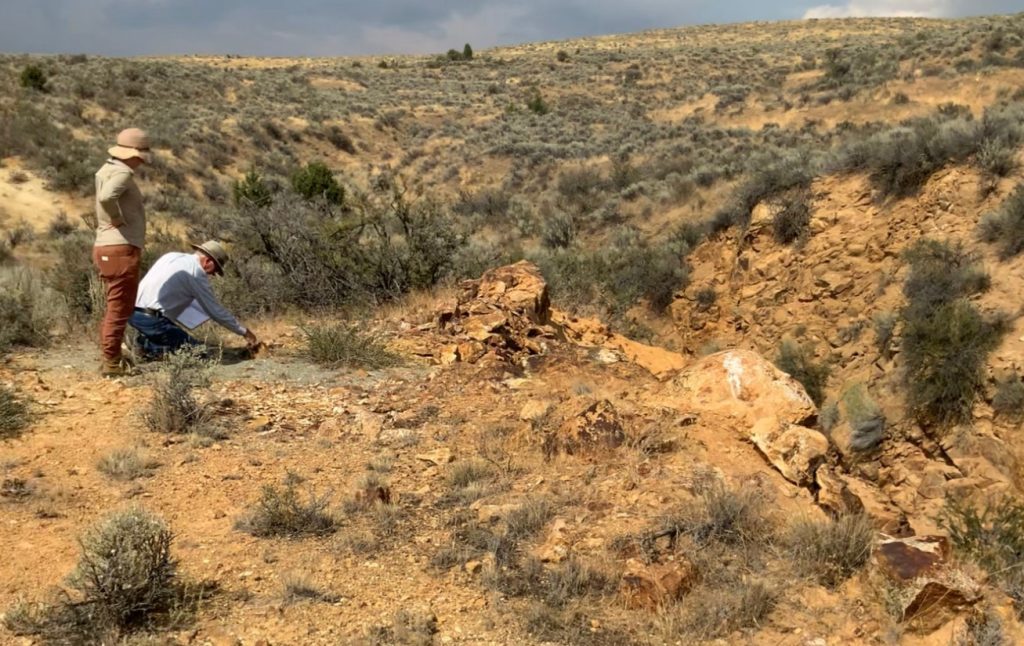Provenance Gold drills 4.59 g/t gold over 23.1 metres at Eldorado, Oregon

Provenance Gold Corp.’s [PAU-CSE; PVGDF-OTCQB] first drilling program at its optioned Eldorado gold project in Malheur County, eastern Oregon, has returned significant gold assays within the first three holes drilled. Reported are the only results received to date, with more holes yet to be drilled and assays pending.
After drilling these first three holes, project manager Steve Craig explained: “This is better than a new discovery because we already know that we have a large, strong gold system. We are confirming historic drilling and testing that outlined an expansive open-ended gold system. These first assays are even better than we expected.”
This initial program is designed to confirm and expand a large, near-surface, open-ended gold system that was outlined by 242 historical drill holes.
Drill hole ED-01 returned 30.48 metres of 0.551 g/t gold and 61n metres of 0.65 g/t gold, including 47.2 metres of 1.108 g/t gold.
ED-02 returned 128 metres of 1.08 g/t gold, including 12.2 metres of 2.14 g/t gold, including 42.9 metres of 2.09 g/t gold, including 10.7 metres of 4.85 g/t gold.
ED-03 returned 140.2 metres of 1.3 g/t gold, including 55.51 metres of 2.92 g/t gold, including 23.1 metres of 4.59 g/t gold.
Provenance’s first hole, ED-01, was designed to confirm continuity of the mineralization in the historically identified gold system outside its higher-grade core area. ED-02, the second hole drilled, was designed to infill an undrilled area within the historical higher-grade core area. The third hole, ED-03, was near historical hole R-136.
ED-01, which was a westward-directed, -55-degree angle hole, supports the continuity of the gold zone mineralization and its impressive thickness that has not previously been tested. It intersected 141 metres of strong gold mineralization, with the best interval being 47.2 metres of 1.108 g/t gold.
Hole ED-02 tested one of several undrilled locations within the historical area of mineralization. Additionally, most of the historical holes were fewer than 90 metres deep, while much of the historical mineralization, including the strongest mineralization, is below 90 metres. Hole ED-02 was a vertical hole drilled to 128 metres, where it bottomed in strong mineralization. The entire 128-metre (420-foot) vertical hole averaged 1.08 g/t gold with the best assay interval at 20.24 g/t gold over 1.5 metres. This hole bottomed in mineralization and has been deepened, with assays pending.
ED-03 was in proximity of historical hole R-136. The holes compare favourably. The entire hole averaged 140 metres of 1.3 g/t gold, within which 23 metres averaged 4.59 g/t gold, with 1.5 metres assaying 20.35 g/t gold. The hole bottomed in 3.205 g/t gold and has been deepened, with assays pending.
Provenance’s initial drilling program is designed to validate the historical drilling by reputable mining companies, including Billiton and ICAN, and to expand on their results.
“These initial results give us additional confidence in the historic work, and in our interpretation that deeper drilling, infill drilling and step-out drilling will significantly expand the historic gold system, which is already large,” said Craig. “Our strong initial assays in historically undrilled locations are validating our view that this mineralized system will grow substantially. Even better, the strongest grades are consistently beneath most of the historic drilling.”
Rauno Perttu, CEO, stated: “This is a game-changer for Provenance. With further drilling, we have the potential to develop a very large gold system. Stay tuned.”
